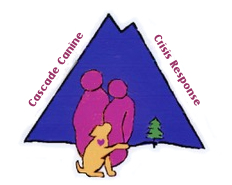The Differences Between Animal Assisted Therapy and Canine Crisis Response
Though the objective of providing comfort & relief is shared by both Animal Assisted Therapy & Canine Crisis Response teams, the latter is an advanced application requiring handler & canine to have proven skills to cope with more intense environments.
Animal Assisted Therapy
- Visits usually regularly scheduled
- Known facility
- Usually have a planned routine in familiar, safe environment
- Usually visit as individual team
- Interactions usually anticipated, though strong emotions possible
- Know what to expect at facility, both clients & staff
- Help is usually available from staff if needed
- Usually no longer than 2 hour visit
- Back to comfy home
- Follow-up and documentation of visit
Canine Crisis Response
- Teams are already experienced & active in Animal Assisted Therapy
- Contact person available 24/7
- Response may be coordinated with multiple teams
- May be scheduled for regular visits, also on call for rapid response
- May need to have plan for getting to location
- Must be flexible to adapt to response timing & site conditions
- Teams prepared for spectrum of trauma-induced emotions of shock, grief, loss
- May be an unfamiliar environment with sensory challenges
- Need to adapt to responders in charge, observe chain of command
- Could be at site for extended period of time
- Individual team documentation submitted following response
- Team debriefing/review & peer support as needed
Learn more about us.
